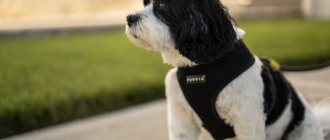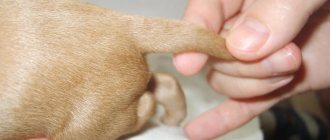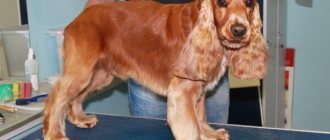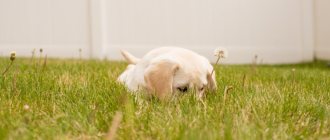- February 21, 2020
- Dogs and hunting with them
- Larisa Kozyrka
Why do you need to dock a spaniel's tail and when is the best time to do this procedure? The tradition of cropping dogs' tails and ears began to spread back in Ancient Rome. Dog fighting was a favorite pastime of that time, and the main goal of docking was the invulnerability of the fighting dog. There is simply nothing for the fighting dog’s opponent to grab him by during the fight. Nowadays, some breeds, and in particular spaniels, also need this procedure.
Often owners attach great importance to docking just because it is considered aesthetically pleasing and beautiful for some dog breeds. Docking spaniels is a standard for this breed, and if this dog is used during hunting, it is also a necessity.
When is ear circumcision performed?
When to crop ears depends on the breed of dog. Usually this is 2.5 or 3 months of age, but in some cases a dog’s ears can be cropped up to a year.
In small breeds of dogs, docking is carried out earlier; in large breeds, which have thick skin, the ears are formed later.
Read also: Profession Instagram administrator
The timing is affected by the shape of the head and its changes with age. In small puppies, it is impossible to determine how the proportions of the head and ears will change after a month or two. Improper trimming can ruin the dog's entire appearance.
Optimal timing
The earlier the operation is performed, the less painful it is for the dog and the faster it is forgotten.
It is considered optimal to trim the tails of blind puppies at the age of 3-5 days (no later than the 10th day). Then the operation is performed without anesthesia.
Read also: Why do you need carbide at a construction site?
Before the age of one and a half months, anesthesia is already necessary, otherwise the pain shock will be too strong.
Adult dogs are rarely docked. It is advisable not to do this without medical indications. An adult dog requires general anesthesia. The risk of complications increases.
Cosmetic surgeries: techniques, postoperative care, complications
The most popular cosmetic surgeries include ear surgery, tail docking, and dewclaw removal. They can be performed for medical reasons or for aesthetic reasons.
Tail docking
Tail docking is performed in one of two ways:
- Bandaging. It is carried out from the 2nd to 4th day of life. The tail is tightened with a thread, an elastic band, a special ring, and sometimes orthodontic thread is applied. This effectively cuts off the blood supply. On average, after 3 days the tail dies and falls off.
- Surgical. A one-time tail trimming at 3-7 days of age using a scalpel or other suitable surgical instrument, with or without sutures.
Complications
Complications after surgery in newborns are rare. This may be bleeding or inflammation in the wound area. Often caused by improper postoperative care or unsanitary conditions in places of detention. In older dogs, the risk of unwanted consequences increases, and prolonged scarring can greatly spoil the appearance. Improper use of the compression ring can cause necrosis and sepsis.
The length of the docked tail depends on the breed and is often specified in the Standard. For example, in a Jack Russell Terrier, the tip of the cut tail should be at ear level when standing.
At what age should a dog's tail be docked?
- 3-10 days
. Veterinarians recommend docking the tail of puppies in the first 3-10 days from birth. During this period, ossification of the tail vertebrae has not yet occurred and pain sensitivity is lower than in older dogs. For such puppies, the operation is performed without anesthesia and without stitches. The breeder or owner is obliged to ensure that the mother of the puppies does not lick the wound, so it will take longer to heal. In this case, the operated animals are isolated and brought in only for feeding time. - from 10 days
. In dogs 10 days and older, the operation is performed under local or general anesthesia. The animal is placed on the operating table in the prone position. The hind and front legs are tied, allowing access to the surgical field. A fixing band is pulled across the body. The jaws are tied with a bandage or a muzzle is put on. - 3-4 weeks
. If the animal is more than 3-4 weeks old, then a tourniquet is applied to the base of the tail.
Short description
Most spaniels are small or medium-sized dogs, the most characteristic external features of which are long floppy ears and a good-natured look of expressive eyes .
Spaniels have coats of different lengths: short on the head and front of the legs, medium length on the body and long in the fringe area.
The body is square or close to square. However, some spaniels, such as Clumbers or Sussexes, have a stretched format, which makes them look rather squat.
The head is proportional to the body, with a flattened or slightly rounded skull and a square muzzle that almost does not taper towards the nose.
The neck is of medium length, with a beautiful curve and proud carriage, the back is straight and level, the chest is well developed, the stomach is slightly tucked.
The limbs are parallel, strong, moderately muscular.
The tail is carried in line with the back or slightly lower. Representatives of many breeds have traditionally docked tails, as this helps to avoid injury during hunting.
The coat of land spaniels is silky and soft.
A characteristic feature of water spaniels is their short hair, which forms small tight curls that protect the dog from water, dirt and adverse weather conditions..
Tail docking
The decision made to circumcise the appendage must be correctly translated into reality:
- Cupping is carried out in the first days of the pet’s life (up to 5 days);
- Further pruning is carried out up to 2.5 months. In this case, the appendix is anesthetized (local), sutures are applied;
- Adult dogs have their tail docked as needed. The procedure is performed under general anesthesia;
- The need is justified by a number of injuries - festering wounds, fractures, burns;
- Surgery is strictly contraindicated for sick puppies.
The need to trim the mobile appendage at an early age is argued for physiological reasons:
- Until 5 days of life, puppies do not see or hear;
- Pain sensations are dulled - pets do not squeak when pruning;
- The wound does not require sutures due to its small size;
- The stump heals quickly due to the peculiarities of the blood supply to this area;
- Moral injury does not occur due to a lack of understanding of what is happening.
Answer
Good afternoon. The question of whether a spaniel's tail needs to be docked is decided individually by the puppy's owner. This is not to say that this is a strict necessity. This procedure will be beneficial for the hunting dog. When getting a companion puppy, it is recommended to leave the tail long. Planning to take your pet to exhibitions and shows since 2006, there is also no need to trim the tail. Now English Cocker Spaniels can be contenders and winners of dog shows with natural length tails! Take everything described into consideration before making such a drastic decision - the mobile appendage will not grow back.
Features of the appearance of the breed
How is the Russian Spaniel different? How to train this breed of dog to hunt? Its representatives have proven themselves well in Russian conditions. In our country, the breed appeared at the turn of the 19th-20th centuries.
The standard for the Russian Spaniel intended for hunting was approved in 1951. Significant diversity in the breed was allowed, which led to the emergence of different regional types with differences.
The modern Russian hunting spaniel has a height at the withers of 40-45 centimeters. The dog is distinguished by a small, dry head and expressive dark eyes. The dog is distinguished by its cheerfulness and lightning-fast movements.
The coat is smooth and wavy, so the Russian Spaniel suffers less from thorns when hunting. The breed is adapted to hunting various game birds in any area of the country. During a hunt, the dog searches for game, reacts to the owner’s shot, and hands the killed bird to the hunter.
How is the operation performed?
Some experienced breeders perform tail docking on spaniel puppies themselves. However, if there is no extensive experience, the participation of a veterinarian is necessary. Remember that we are talking about, albeit a small, but still a surgical operation. The veterinarian can come to your home or perform the procedure in the clinic.
During the operation the following are used:
- surgical scissors, scalpel or blade;
- antiseptic.
A five-day-old cocker spaniel is the size of your palm. He is placed on the table tummy down and pressed lightly. A tourniquet is applied to the base of the tail. The owner or clinic employee secures the animal. The doctor pulls the skin on the tail to the base, counts 4-5 vertebrae and trims it in one movement. This is done only with a sterile instrument.
Then the puppy is turned over on its back and the cut is treated with an antiseptic. After this, the puppy can be returned to its mother, she will lick the wound. The whole procedure takes no more than half an hour, including the preparation of instruments.
Older dogs are given anesthesia (local or general anesthesia, depending on age).
Stitches are placed on the wound. It is preferable if the seams are made with self-absorbing threads. The procedure takes longer because the anesthesia takes time to take effect.
Important tip
Some dog breeders do docking for their dog themselves. This should not be done, since this is an operation that requires strict sterility and compliance with certain rules for this procedure. According to statistics, most often suppuration of the circumcised area occurs due to non-compliance with all sterility rules during cupping. Remember that it is better to keep the dog's entire tail than to end up with a pet with an ugly, crooked stump. Whether or not to carry out such a procedure is a subjective decision.
Dates
At what age is a spaniel's tail docked? Veterinarians are convinced that the earlier the operation is performed, the more painless it is for the dog and the faster the recovery process.
It is considered optimal to trim the tails of blind puppies whose age is 3-5 days. In this case, the operation can be performed without the use of anesthesia. If a Russian hunting spaniel loses its tail at one and a half months of age, anesthesia will be required for the operation. An adult dog requires general anesthesia, which significantly increases the risk of various complications.
Accepted Standards
- The breed standard does not regulate the shape and length of the tail.
- The appendage may be trimmed and long.
- The shape can range from log-like to twisted into a ring.
- In some Scandinavian countries, docking is prohibited by law.
The ideal time for tail docking for American Cocker Spaniels is up to 5 days after the puppies are born! Based on the question posed, we recommend keeping it within 2 weeks of your pet’s life.
Interestingly, there is a rule about the length of the tail that is left after the appendage is trimmed. The length is about 19 mm. This standard corresponds to puppies whose age is no more than 1 week. The rule applies to the American Cocker Spaniel breed. At an older age, circumcision occurs at ½ length.
Carrying out the operation
Since a spaniel with an undocked tail is not suitable for hunting, many breeders perform docking surgery on their spaniel puppies themselves. If the dog owner does not have the appropriate experience, then it is better to entrust the surgical operation to an experienced veterinarian. It uses a blade, a scalpel or surgical scissors, as well as an antiseptic substance.
At 3-5 days of age, the spaniel is the size of a palm. The puppy is placed belly down on the table, then pressed lightly. A tourniquet is applied to the tail. Next, the animal is fixed, the skin on the tail is pulled to the base, 4-5 vertebrae are counted, then cut off in one motion using a sterile instrument.
Next, the puppy is placed on its back and the cut is treated with an antiseptic. The baby is returned to his mother, who licks his wounds. The procedure lasts no more than 30 minutes, including preliminary preparation of instruments.
Older dogs must be given anesthesia: general or local anesthesia. Next, stitches are placed on the wound using self-absorbing threads.
Preparing for the hunt
Training a dog involves teaching a spaniel to search for various birds, lifting it from the ground “on the wing” when the hunter shoots, searching for and presenting downed game. Dogs of this breed are suitable for hunting pine, field, swamp, and waterfowl game. Marsh game includes marsh partridges, grouse, great snipe, and snipe. Representatives of field game: partridge, pheasant, corncrake, quail. Hunters consider black grouse, wood grouse, and white partridge to be upland game. A typical representative of waterfowl is the duck. In addition to hunting various birds, spaniels are actively used for hunting squirrels and hare.
Each animal and bird has its own habits and specific smell. During training, the hunter introduces the spaniel to the habits and smell of the animal or bird being trained. A spaniel trained for hunting one animal (a specific bird) works perfectly only for this, but for other types of prey it does not fully help the owner. Professionals are convinced that there is no point in training a dog for all types of game at once, because amateur hunters usually prefer a specific type of game. Of course, when selecting an animal or bird for which a spaniel will be trained, its owner uses personal preferences and takes into account the specifics of the area and the game that lives there.
Character of the American Cocker Spaniel
During selection, breeders paid attention to appearance, so the hunting qualities of these dogs were almost lost. American spaniels have evolved into family dogs. This fluffy cute dog is very loyal and devoted. He is ready to follow his owner and participate in all activities and games. But the spaniel is very sensitive, he understands when the owner is busy and will not bother him. And if someone is sad, they will definitely calm and cheer them up. He treats strangers calmly and does not show aggression. Therefore, this dog cannot be made into a guard or watchman.
He is a cheerful and good-natured fidget, he is always looking for something to do. Cockers are cheerful, sad only when separated from their owner. They definitely need the presence of a person who loves them. When alone, they will whine and may start to damage things.
Cockers love all family members and treat children with tenderness. Adult dogs control themselves and will never offend a child. They live quietly in the same house with all pets, except birds. Hunting instincts force the dog to hunt them.
Of the negative character traits, cockers have cunning and the ability to manipulate. They feel when the owner shows weakness and will take advantage of it.
Features of education and training
From the first day a puppy appears in the house, it is necessary to begin education and socialization. Although this dog is smart and obedient, it has an explosive temperament. Without proper upbringing, she can become aggressive and uncontrollable. The owner must show persistence and patience. The dog must understand who is boss in the house.
You need to immediately teach your baby:
- go to the toilet for a diaper, and then go outside;
- calmly endure hygiene procedures;
- know your place, go there on command;
- do not climb on the bed;
- don't bite;
- don't just bark;
- respond to a nickname;
- walk with a collar and leash;
- calmly react to strangers, other dogs and animals, cars, noise.
Mandatory commands that every dog should know are “come to me”, “stand”, “sit”, “near”, “no”, “fu”. It is also recommended to teach the American Spaniel the “quiet” command, as these dogs love to express their emotions with their voices.
Exercises with your pet should be regular and consistent. It is better to conduct them in a playful way to interest the baby. They love to play catch, search for and bring objects. It is recommended to reward correct behavior with treats and affection. But mistakes and mischief should not be forgiven; you should immediately scold the puppy. Just don’t scream, much less hit your pet. He should not be afraid of his owner.
The American Cocker is easy to train. This dog loves to learn new things, he is curious and smart. He wants to please his beloved owner, so he will obey and loves attention and praise.
If a dog is bought for hunting, it needs to be trained from an early age. The hunting skills of American cockers are weak, so they need to be trained to smell game and search for prey. It is advisable to have this done by a professional.
Cost and where they make it
Operations are carried out both at home and in specialized veterinary clinics. In Russia, you can dock a puppy’s tail within 500 rubles. But ear cropping, due to the complexity of the procedure, will cost more - in the amount of 2-4 thousand rubles.
In some countries, docking dogs is prohibited. These countries include: Austria, Belgium, Great Britain, Germany, Greece, Denmark, Ireland, Iceland, Spain, Italy, Latvia, Lithuania, Luxembourg, the Netherlands, Norway, Poland, Portugal, Slovenia, Ukraine, Finland, Czech Republic, Switzerland, Sweden , Estonia.
That is, in all EU countries, docking of dogs is unacceptable and is carried out only at home. In the US and some other countries, docking is still acceptable.
How to choose a puppy
You should always purchase a puppy from trusted breeders with a good reputation, since only they can guarantee the purity of the breed. The advantage will be that they will predict the dog’s character and give the necessary advice on maintenance and care.
When buying a pet you need:
- meet the puppy’s parents and their documents;
- check pedigree;
- pay attention to the voice (it should be loud), the activity of the puppy.
Note! If you are not confident in your knowledge and do not trust the breeder, then you should find an independent expert who can help you choose.
Bitch milk
The bitch's milk at different stages of feeding puppies has a different composition. It is especially important for newborns to suck out maternal colostrum immediately after birth. It contains substances that help cleanse the digestive tract of embryonic feces, a whole set of enzymes, and most importantly, a brood of gastrointestinal microflora, which throughout the dog’s life provides protection for its body from all kinds of putrefactive and other pathogenic microorganisms. An indicator of the puppies' satiety is their calm behavior. After all, in the first days, if there is enough milk, the puppies either sleep or suck, and squeak slightly only when they need maternal attention to fulfill their needs. Lack of milk causes long-term anxiety in puppies. In this case, you need to check the condition of the mother, her milk supply, and if there is a lack of milk, increase the diet at the expense of the protein portion, soups and dairy products.











